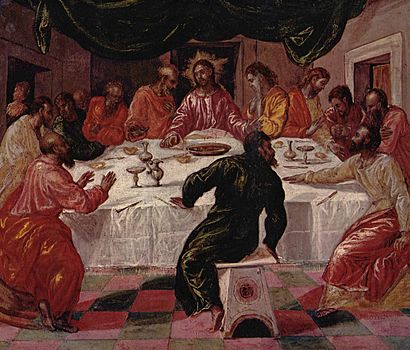Last Supper (El Greco) facts for kids
Quick facts for kids Last Supper |
|
|---|---|
 |
|
| Artist | El Greco |
| Year | 1568 |
| Medium | Oil on canvas |
| Dimensions | 43 cm × 52 cm (17 in × 20 in) |
| Location | Pinacoteca Nazionale di Bologna |
Last Supper is a famous painting created in 1568 by a Greek artist named Doménikos Theotokópoulos. He is much better known by his nickname, El Greco. El Greco was a painter, sculptor, and architect during the Spanish Renaissance.
This painting shows a very important moment from the Bible, known as the Last Supper. It is currently kept in a museum called the Pinacoteca Nazionale di Bologna in Italy.
Who Was El Greco?
El Greco (1541–1614) was born on the island of Crete, which was part of Greece at the time. His name "El Greco" actually means "The Greek" in Spanish. He trained as an artist in his home country before moving to Italy. In Italy, he learned from famous artists like Titian and Tintoretto.
Later, El Greco moved to Spain, where he spent most of his life. He became very well known for his unique style. His paintings often feature long, stretched-out figures and dramatic colors. He used light and shadow in a special way to create strong emotions.
About the Last Supper Painting
The painting Last Supper by El Greco shows Jesus Christ and his twelve disciples sharing their final meal together. This event is very important in Christianity. During this meal, Jesus told his disciples that one of them would betray him. He also shared bread and wine, which became symbols for many Christian traditions.
El Greco's painting captures the feeling of this moment. Even though it's an early work by him, you can start to see hints of the unique style he would become famous for. The painting is done with oil paints on a canvas. It measures 43 centimeters tall and 52 centimeters wide.
Where Can You See It?
Today, you can see El Greco's Last Supper painting at the Pinacoteca Nazionale di Bologna. This is a national art gallery located in Bologna, Italy. It has many important artworks from different periods, especially from the 13th to the 18th centuries.
See also
 In Spanish: La última cena (El Greco) para niños
In Spanish: La última cena (El Greco) para niños
- List of works by El Greco

